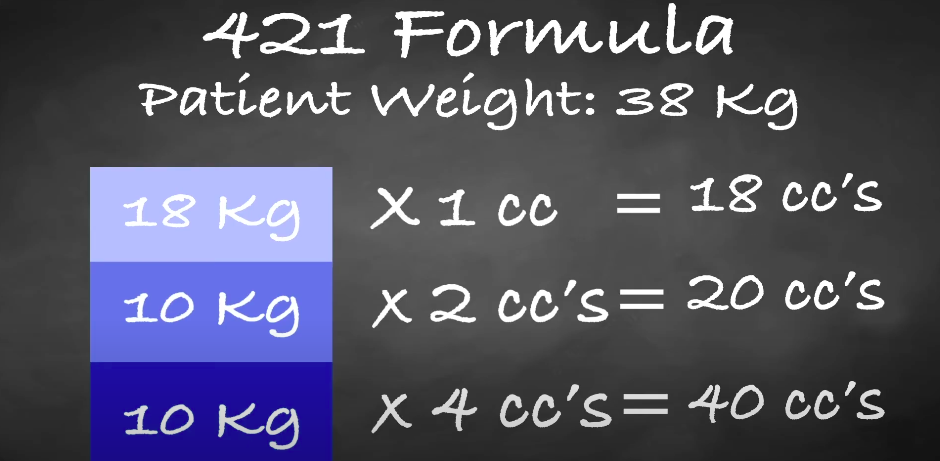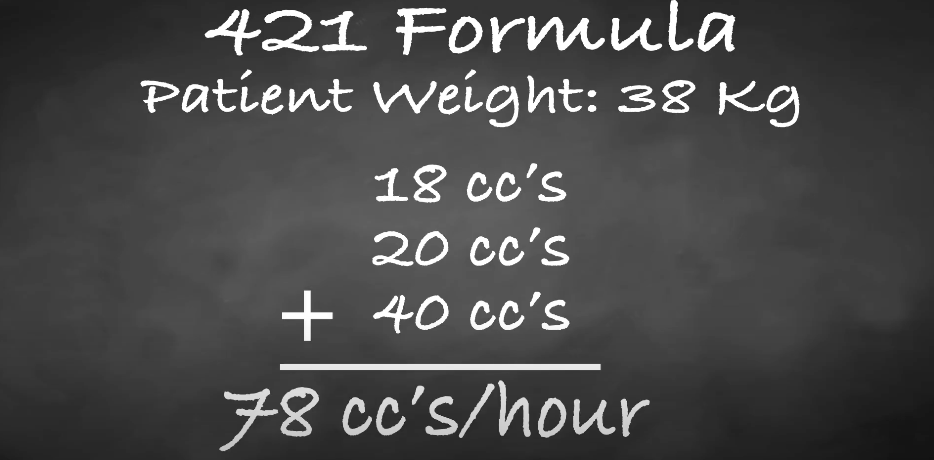Reviewing the 421 Formula for IV Rates
ACLS Certification Association videos have been peer-reviewed for medical accuracy by the ACA medical review board.
Article at a Glance
- In PALS, the 4-2-1 formula assists the provider in calculating maintenance IV rates for pediatric patients.
- The provider must know the child’s weight in kilograms.
- The 4 refers to infusing 4 mLs of fluid for the first 10 kg bodyweight.
- The 2 refers to infusing 2 mLs of fluid for the next 10 kg bodyweight.
- The 1 refers to infusing 1 mLs of fluid for bodyweight left over.
- Add the three numbers to get the total hourly amount for fluid maintenance.
The 4-2-1 formula (also known as the 4-2-1 rule) calculates maintenance IV infusion rates in pediatric patients. The first important measurement is the patient’s weight in kilograms. For example, a pediatric patient weighs 38 kg. We’ll administer 4 mL/kg for the first 10 kg of body weight. 10 times 4 is 40 mL, which is the “4” in “421”. Therefore, we’ll administer 40 mL of IV fluid for the first 10 kg of body weight. Next, we administer 2 mL/kg of the next 10 kg of body weight. 10 times 2 is 20 mL, which is the “2” in “421”. Finally, we administer 1 mL/kg of body weight for the remaining weight or 18 kg in this example. Multiply 1 by 18, which is 18 mL. The 4-2-1 formula calculates the maintenance IV fluid infusion rate for pediatric patients. The sum of all three numbers is the child’s hourly infusion IV rate. For this child, the hourly maintenance IV infusion rate is 40 + 20 + 18 = 78 mL per hour. The total of all three calculations gives the maintenance IV rate in mL per hour. Note that mL and cc are equivalent. Read: General Stroke CareReviewing the 4-2-1 Formula


Summary
To calculate the maintenance IV rate per hour for a child, use the 4-2-1 rule. Calculate 4 mL/kg for the first 10 kg of body weight, 2 mL/kg of the next 10 kg of body weight, and 1 mL/kg of every kg after that. Add all three numbers to get the IV rate per hour.
Related Video – One Quick Question: How Do You Calculate IV Drip Rates?
Related Video – What are Intravenous (IV) Fluids?
More Free Resources to Keep You at Your Best
Editorial Note
ACLS Certification Association (ACA) uses only high-quality medical resources and peer-reviewed studies to support the facts within our articles. Explore our editorial process to learn how our content reflects clinical accuracy and the latest best practices in medicine. As an ACA Authorized Training Center, all content is reviewed for medical accuracy by the ACA Medical Review Board.

